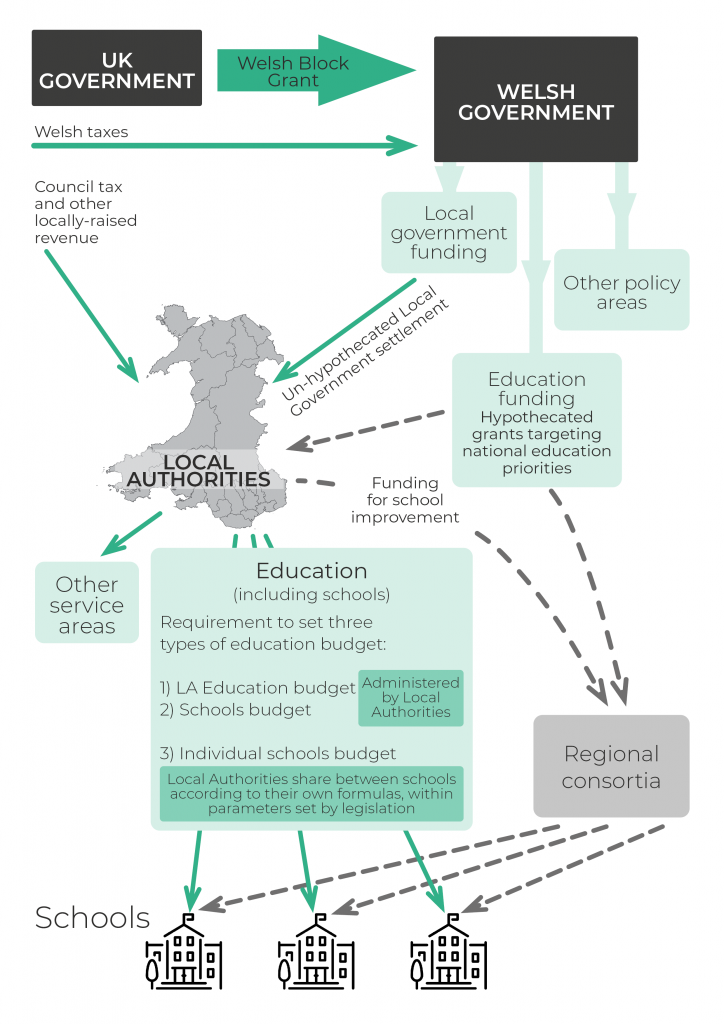On Wednesday (23 October 2019), Assembly Members will debate the Children, Young People and Education (CYPE) Committee’s report into School Funding (PDF 1MB) and the Welsh Government’s response (PDF 703KB).
The Committee’s main recommendation, which the Welsh Government has accepted, is that it commission an urgent review of how much funding schools need, particularly given the level of reform currently being undertaken in education.
Although not part of the formal recommendation, the Committee suggested that the review should be undertaken with a similar objective to the 2014 Nuffield Review, which considered the funding gap facing the Welsh NHS.
Why is school funding such a topical issue?
Stakeholders, including teaching unions and local authorities, are concerned that insufficient funding risks the successful delivery of key reforms such as the new curriculum and the implementation of the new Additional Learning Needs (ALN) system, as well as meeting the priority of school improvement and raising standards.
The CYPE Committee’s report highlights that the pressure on school budgets and the effect this has on children and young people’s education has been regularly raised during its scrutiny work over the past few years.
Concerns were also expressed about a lack of transparency and inconsistencies in the distribution of funding to schools, in particular, the balance of funding for schools’ core budgets (provided via local authorities) and national education priorities (provided by the Welsh Government).
The CYPE Committee therefore looked at both the sufficiency of provision for school budgets and the way that funding for schools is determined and allocated.
School funding: a complex arrangement
The process for allocating and distributing school funding is complex, as illustrated in our infographic below (for a more detailed explanation, see our guide to School Funding in Wales, August 2018).
The process for arriving at a school’s core budget is multi-layered and based on a number of different factors, which can be summarised as follows:
- How much money is available to the Welsh Government as a whole (largely determined by Westminster);
- How the Welsh Government divides up its resources between policy areas and how much it gives to local government as a whole;
- How the Welsh Government divides the local government settlement between each authority;
- Because the local government settlement is unhypothecated, how much priority each local authority gives to education, and specifically school budgets, amidst funding pressures on other service areas;
- The extent to which local authorities delegate education funding to schools and how much they retain for centrally provided services;
- How local authorities allocate funding between schools (they do this using their own formula within the parameters of the School Funding Regulations (Wales) 2010).
Whilst the vast majority of funding for schools is allocated via local authorities, the Welsh Government’s education budget provides additional funds for specific, targeted purposes. Some of this money goes in its entirety to schools, for example the Pupil Development Grant (PDG) but much of it is channelled through the four regional consortia (PDF 1MB).
Current school funding levels
The table below shows how much has been budgeted for expenditure on schools since 2010-11:
Table 1: Gross budgeted expenditure on schools
 Source: Extracted from Welsh Government, Statistical Bulletin: Local authority budgeted expenditure on schools (several annual editions).
Source: Extracted from Welsh Government, Statistical Bulletin: Local authority budgeted expenditure on schools (several annual editions).
The data in Table 1 shows that:
- In 2019-20, £2.654 billion is budgeted for expenditure on schools, 3.4% higher than 2018-19.
- Between 2010-11 and 2019-20, gross budgeted expenditure on schools increased by 8.0% in cash terms (£196 million), a 7.6% decrease in real terms (at 2019-20 prices, using HM Treasury GDP deflators, September 2019).
- In 2019-20, £5,849 per pupil is budgeted for expenditure on schools, 3.1% higher than 2018-19.
- The per pupil amount budgeted in 2019-20 is 8.1% higher in cash terms (£440) than in 2010-11, a 7.5% decrease in real terms (at 2019-20 prices, using HM Treasury GDP deflators, September 2019).
- In 2019-20, on average across Wales, 83.9% of budgeted expenditure is delegated to schools, an increase from 75.0% in 2010-11.
Comparisons with England
The Welsh Government stopped publishing data on school funding levels in Wales and England in 2011, stating that it was no longer possible to produce robust, comparable data. However, in 2018, the Institute of Fiscal Studies’ analysis concluded that once London is discounted, there is virtually no difference in per pupil funding between Wales and England (see page 21 of School Funding in Wales for more information).
How is school funding used?
Local authorities provide the vast majority of funding for schools’ core budgets, which comes from the un-hypothecated local government settlement (£2.015 billion of the total £2.654 billion in 2019-20).
An additional £428 million is retained and administered by local authorities for services which may be provided centrally for reasons of efficiency, economies of scale or because they are specialised or essentially central services, such as school transport.
A further £211 million of grant funding is devolved to schools, alongside their core budget.
The four regional consortia receive approximately £11 million per year from local authorities for their school improvement services and are responsible for distributing around £140 million of Welsh Government grant funding (these amounts are part of the figures cited above).
Table 2: Breakdown of gross budgeted expenditure on schools in 2019-20
 Source: Extracted from Welsh Government, StatsWales: Budgeted education revenue expenditure by authority and service and Delegated School Budgets by sector
Source: Extracted from Welsh Government, StatsWales: Budgeted education revenue expenditure by authority and service and Delegated School Budgets by sector
How has the Welsh Government responded?
The Welsh Government accepted all 21 of the CYPE Committee’s recommendations.
In total, the Committee’s 21 recommendations focused on the following areas (the numbers in brackets denote the number of recommendations):
- The sufficiency of funding for schools and the priority given to education by the Welsh Government and local authorities (3)
- The Welsh Government’s allocation of available resources between local authorities (1)
- Local authorities’ prioritisation of funding for schools (3)
- Local authorities’ apportioning of the funding they make available for schools, between schools (2)
- Unhypothecated funding and targeted funding (2)
- School budget reserves and deficits (3)
- Three-year budgets for schools (1)
- The role of the ‘middle tier’ (local authorities and regional consortia) (1)
- Potential duplication of expenditure on school improvement (2)
- The proportion of funding that is delegated to schools (3)
As stated previously, the Committee’s recommendations included that there is an urgent review to assess how much funding schools require to deliver on their responsibilities, including implementing the considerable reforms underway. The Minister for Education, Kirsty Williams AM, is expected to give more details during the Plenary debate on how this school funding review will be taken forward.
How to follow the debate
The debate is scheduled for Wednesday 23 October 2019 at approximately 4.25pm. The Plenary session will be broadcast on Senedd TV and a transcript will be available on the Assembly’s Record of Proceedings.
Article by Michael Dauncey, Senedd Research, National Assembly for Wales







